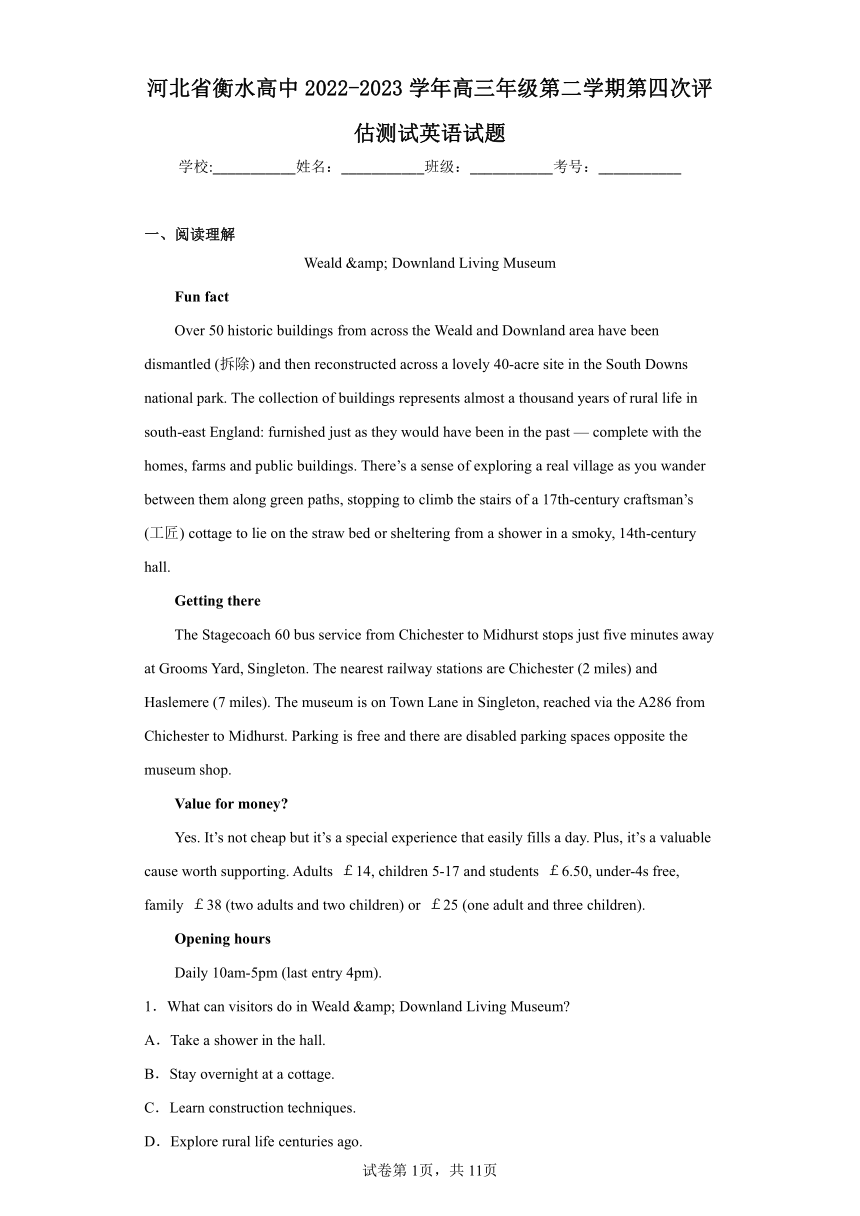
河北省衡水高中2022-2023学年高三年级第二学期第四次评估测试英语试题 学校:_____姓名:_____班级:_____考号:_____ 一、阅读理解 Weald & Downland Living Museum Fun fact Over 50 historic buildings from across the Weald and Downland area have been dismantled (拆除) and then reconstructed across a lovely 40-acre site in the South Downs national park. The collection of buildings represents almost a thousand years of rural life in south-east England: furnished just as they would have been in the past — complete with the homes, farms and public buildings. There’s a sense of exploring a real village as you wander between them along green paths, stopping to climb the stairs of a 17th-century craftsman’s (工匠) cottage to lie on the straw bed or sheltering from a shower in a smoky, 14th-century hall. Getting there The Stagecoach 60 bus service from Chichester to Midhurst stops just five minutes away at Grooms Yard, Singleton. The nearest railway stations are Chichester (2 miles) and Haslemere (7 miles). The museum is on Town Lane in Singleton, reached via the A286 from Chichester to Midhurst. Parking is free and there are disabled parking spaces opposite the museum shop. Value for money Yes. It’s not cheap but it’s a special experience that easily fills a day. Plus, it’s a valuable cause worth supporting. Adults £14, children 5-17 and students £6.50, under-4s free, family £38 (two adults and two children) or £25 (one adult and three children). Opening hours Daily 10am-5pm (last entry 4pm). 1.What can visitors do in Weald & Downland Living Museum A.Take a shower in the hall. B.Stay overnight at a cottage. C.Learn construction techniques. D.Explore rural life centuries ago. 2.How much would a couple with their 5-year-old twin sons pay for admission A.£25. B.£34.5. C.£38. D.£41. 3.What do we know about Weald & Downland Living Museum A.It charges parking fees. B.It has varied opening hours. C.It is inconveniently located for bus riders. D.It offers the disabled thoughtful service. On a hot summer afternoon along the Mandavi River, Shweta Hule wraps her sari around her ankles and bends to pick wild “weeds” from the river and drop them into a bowl. The plants will be made into fritters (炸果饼), to be served at the little restaurant attached to the B&B Hule manages in the Indian coastal town of Vengurla. Wild edible (可食用的) plants are common in kitchens here. Hule’s weed is juicy, which is found in mangrove forests. Harvesting some of the plant is helping conserve the mangroves, a globally endangered ecosystem of salt-tolerant trees that stop coastal erosion (侵蚀) and absorb storm damage. Hule is head of Swamini, a self-help group set up by nine women from a fishing community in Vengurla who started Mandavi Eco Tourism in 2017. Vengurla is known for its beautiful beaches and seafood, but the climate crisis has made fishing for a living unsustainable, so people are trying to find other sources of income. They came up with the idea o ... ...
~~ 您好,已阅读到文档的结尾了 ~~